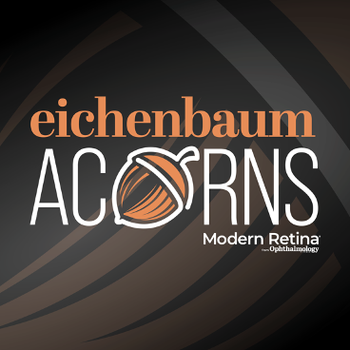
Addressing the urgent, unmet need among patients with geographic atrophy
Study demonstrates results of pegcetacoplan as a geographic atrophy therapy.
Reviewed by Jeffrey Heier, MD.
New 18-month data from the phase 3 DERBY and OAKS trials showed that pegcetacoplan (Apellis Pharmaceuticals, Inc), an investigational therapy targeting complement protein C3, continued to show potential improving effects over time in geographic atrophy (GA) secondary to age-related macular degeneration (AMD).
These top-line results indicated that the treatment slows disease progression and can potentially preserve vision for a longer period in this patient population. Because no approved therapies are yet available for GA, an advanced stage of AMD, this is a major step forward in the treatment of AMD.
“Pegcetacoplan is the only therapy to continuously reduce GA lesion growth across a large and broad patient population in phase 3 studies,” said Federico Grossi, MD, PhD, chief medical officer at Apellis Pharmaceuticals. “Building on our 12-month results, both monthly and every-other-month pegcetacoplan demonstrated clinically meaningful effects and a favorable safety profile with longer-term use.”
Jeffrey Heier, MD, principal investigator of the DERBY study and director of both vitreoretinal service and retinal research at Ophthalmic Consultants of Boston in Massachusetts, sees potential for pegcetacoplan to fill a gap in the treatment of this retinal disease.
“In my practice, I have seen how devastating it can be for people living with GA to lose more of their vision year after year,” Heier said. “There is an urgent unmet need in GA, and these results reinforce the potential of pegcetacoplan to become the first-ever treatment for patients with this debilitating disease.”
The multicenter, randomly assigned phase 3 DERBY (NCT03525600) and OAKS studies (NCT03525613) included a total of 1258 patients. The primary objective of the studies was to evaluate the efficacy of pegcetacoplan compared with sham therapy in patients with GA; efficacy was assessed based on changes in the total area of the GA lesions from baseline.
Phase 3 OAKS and DERBY trial data
The OAKS data analysis showed that both monthly and every-other-month pegcetacoplan treatment reduced growth of GA lesions by 22% and 16%, respectively, both of which reached significance (P < .0001 and P = .0018).
In the DERBY trial, the respective results were 13% and 12% for the monthly and every-other-month treatments, and these also reached significance (P = .0254 and P = .0332).
The patients in the DERBY trial experienced marked improvements during treatment months 6 to 12. The reductions in GA growth were 17% and 16% with monthly and every-other-month treatments, respectively, compared with the results from months 0 to 6, and this treatment effect was sustained through month 18. The DERBY results observed were comparable with those seen in the OAKS trials during 6 to 18 months of treatment.
When the 18-month data from both trials were combined, it showed the potential for improving treatment effects over time with pegcetacoplan. In addition, the agent’s safety profile remained favorable over time, out to 18 months. This is consistent with the drug’s safety profile at the 12-month time point and longer-term exposure to intravitreal injections.
Specifically, the safety data showed a rate of infectious endophthalmitis of 0.044% per injection and a rate of intraocular inflammation of 0.23% per injection. These incidence rates are similar to those reported previously in studies that evaluated treatment with other intravitreal therapies.1-3
No cases of retinal vasculitis or retinal vein occlusion were reported. The combined rates of new-onset exudations at month 18 were 9.3%, 6.2%, and 2.9%, respectively, in the monthly pegcetacoplan, every-other-month pegcetacoplan, and sham groups.
“The combined data showed the reduction in GA lesion growth improved with monthly pegcetacoplan treatment from 13% to 21% from months 0 to 6 to months 12 to 18,” the investigators concluded. “The reduction in GA lesion growth improved with every-other-month pegcetacoplan treatment from 12% to 17% from months 0 to 6 to months 12 to 18.”
The data will be included in the company’s new drug application submission to the FDA in the second quarter of 2022.
References
1. Morioka M, Takamura Y, Nagai K, et al. Incidence of endophthalmitis after intravitreal injection of an anti-VEGF agent with or without topical antibiotics. Sci Rep. 2020;10(1):22122. doi:10.1038/s41598-020-79377-w
2. Kiss S , Dugel PU , Khanani AM , et al. Endophthalmitis rates among patients receiving intravitreal anti-VEGF injections: a USA claims analysis. Clin Ophthalmol. 2018;12:1625-1635. doi:10.2147/OPTH.S169143
3. Cox JT, Eliott D, Sobrin L. Inflammatory complications of intravitreal anti-VEGF injections. J Clin Med. 2021;10(5):981. doi:10.3390/jcm10050981
Newsletter
Keep your retina practice on the forefront—subscribe for expert analysis and emerging trends in retinal disease management.















































